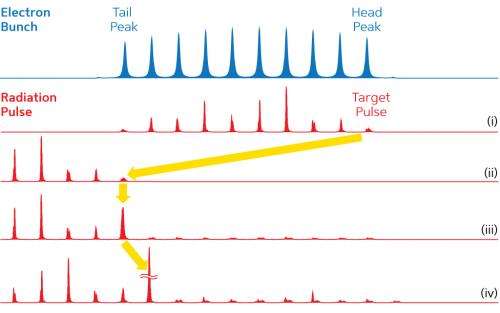X-rays in the fast lane

X-ray free-electron lasers (XFELs) produce higher-power laser pulses over a broader range of energies compared with most other x-ray sources. Although the pulse durations currently available are enormously useful for the study of materials, even shorter pulses are needed to observe features such as electrons at subatomic scales. Takashi Tanaka from the RIKEN SPring-8 Center has now proposed a theoretical pulse-amplification scheme that allows for the production of ultrashort x-ray pulses at extremely high energies.
Methods previously proposed for shortening XFEL laser pulses typically fail to deliver sufficiently high energies for practical use. "In order to observe the motion of electrons inside atoms and molecules during chemical processes, shorter and brighter x-ray pulses are needed," says Tanaka.
The researcher's proposed solution involves shortening the electron pulse used to generate the x-rays by filtering out all but the middle part of the pulse, rejecting the weakest leading and trailing pulse components. The filtered electron pulse is then sent on a curved path—helped by a matching optical laser that stabilizes the electron movements—to divide the electron pulse into a series of small 'bunches'.
These electron bunches are then converted into weak x-ray laser pulses, which are sent through a delay line that shifts the leading 'target' pulse so as to coincide with the last of the corresponding electron bunches (Fig. 1). In a further amplification process, the target pulse is strengthened using a laser, leaving the rest of the pulses unaltered.
Repetition of this last step a number of times amplifies the target pulse by many orders of magnitude. The predicted peak power is on the order of terawatts—more than the combined power output of all the nuclear power plants in the world. In addition, the predicted pulse duration is impressively short at 53 attoseconds, a duration which corresponds to traveling a distance of less than 16 nanometers at the speed of light.
Currently, the combination of exceptionally high power and short pulse length would be unmatched and could open many possibilities for the study of materials under extreme conditions. Tanaka expects the next step to be the realization of his proposal using the facilities at RIKEN's SPring-8 synchrotron complex in Harima. "We'd like to implement this scheme in the near future, but before that we need to develop relevant components such as the magnets needed to precisely control the timing between the electron and x-ray pulse," says Tanaka.
More information: Tanaka, T. Proposal for a pulse-compression scheme in x-ray free-electron lasers to generate a multiterawatt, attosecond x-ray pulse. Physical Review Letters 110, 084801 (2013). dx.doi.org/10.1103/PhysRevLett.110.084801
Journal information: Physical Review Letters
Provided by RIKEN




















